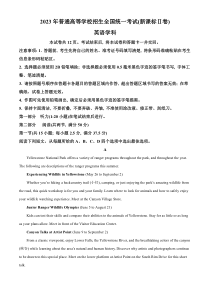 PDF
PDF
【文档说明】2023年高考真题——英语(新高考II卷) .pdf,共(13)页,265.693 KB,由envi的店铺上传
转载请保留链接:https://www.doc5u.com/view-cea98dd2a5d3bdd54479a9cfb1345720.html
以下为本文档部分文字说明:
2023年普通高等学校招生全国统一考试(新课标Ⅱ卷)英语学科本试卷共12页。考试结束后,将本试卷和答题卡一并交回。注意事项:1.答题前,考生先将自己的姓名、准考证号码填写清楚,将条形码准确粘贴在考生信息条形码粘贴区。2.选择题必须使用2B铅笔填涂;非选择题必须使用0.5毫米黑色字
迹的签字笔书写,字体工整、笔迹清楚。3.请按照题号顺序在答题卡各题目的答题区域内作答,超出答题区域书写的答案无效;在草稿纸、试卷上答题无效。4.作图可先使用铅笔画出,确定后必须用黑色字迹的签字笔描黑。5.保持卡面清洁,不要折叠,不
要弄破、弄皱,不准使用涂改液、修正带、刮纸刀。第一部分听力(1-20小题)在笔试结束后进行。第二部分阅读(共两节,满分50分)第一节(共15小题;每小题2.5分,满分37.5分)阅读下列短文,从每题所给的A、B、C、D四个选项中选出最佳选项。AYellowstoneN
ationalParkoffersavarietyofrangerprogramsthroughoutthepark,andthroughouttheyear.Thefollowingaredescriptionsoftherangerprogramsthissummer.Experienc
ingWildlifeinYellowstone(May26toSeptember2)Whetheryou’rehikingabackcountrytrail(小径),camping,orjustenjo
yingthepark’samazingwildlifefromtheroad,thisquickworkshopisforyouandyourfamily.Learnwheretolookforanimalsandhowtosafelyenjoyyourwildlifewatching
experience.MeetattheCanyonVillageStore.JuniorRangerWildlifeOlympics(June5toAugust21)KidscantesttheirskillsandcomparetheirabilitiestotheanimalsofYello
wstone.Stayforaslittleoraslongasyourplansallow.MeetinfrontoftheVisitorEducationCenter.CanyonTalksatArtistPoint(June9toSeptember2)Fromaclassicviewpoin
t,enjoyLowerFalls,theYellowstoneRiver,andthebreathtakingcolorsofthecanyon(峡谷)whilelearningaboutthearea’snaturalandhumanhi
story.Discoverwhyartistsandphotographerscontinuetobedrawntothisspecialplace.MeetonthelowerplatformatArtistPointontheSouthRimDriveforth
isshorttalk.PhotographyWorkshops(June19&July10)Enhanceyourphotographyskills—joinYellowstone’sparkphotographerforahands-onprogramtoinspirene
wandcreativewaysofenjoyingthebeautyandwonderofYellowstone.6/19—Waterfalls&WideAngles:meetatArtistPoint.7/10—Wildflowers&WhiteBalance:meetat
WashburnTrailheadinChittendenparkingarea.1.Whichofthefourprogramsbeginstheearliest?A.PhotographyWorkshops.B.Junio
rRangerWildlifeOlympics.C.CanyonTalksatArtistPoint.D.ExperiencingWildlifeinYellowstone.2.Whatistheshorttalk
atArtistPointabout?A.Worksoffamousartists.B.Protectionofwildanimals.C.Basicphotographyskills.D.Historyofthecanyonarea.3.Wherewillthepar
ticipantsmeetfortheJuly10photographyworkshop?A.ArtistPoint.B.WashburnTrailhead.C.CanyonVillageStore.D.VisitorEducation
Center.BTurningsoil,pullingweeds,andharvestingcabbagesoundliketoughworkformiddleandhighschoolkids.Andatfirstitis,saysAbbyJaram
illo,whowithanotherteacherstartedUrbanSprouts,aschoolgardenprogramatfourlow-incomeschools.Theprogramaimstohelpstudentsdevelopscience
skills,environmentalawareness,andhealthylifestyles.Jaramillo’sstudentsliveinneighborhoodswherefreshfo
odandgreenspacearenoteasytofindandfastfoodrestaurantsoutnumbergrocerystores.“Thekidsliterallycometos
choolwithbagsofsnacksandlargebottlesofsoftdrinks,”shesays.“Theycometousthinkingvegetablesareawful,dirtisawful,insectsareawful.”Thoughsomeareinitiall
yscaredoftheinsectsandturnedoffbythedirt,mostareeagertotrysomethingnew.UrbanSprouts’classes,attwomiddleschoolsandtwo
highschools,includehands-onexperimentssuchassoiltesting,flower-and-seeddissection,tastingsoffreshordriedp
roduce,andworkinthegarden.Severaltimesayear,studentscookthevegetablestheygrow,andtheyoccasionallymakesaladsfort
heirentireschools.Programevaluationsshowthatkidseatmorevegetablesasaresultoftheclasses.“Wehavestudentswhosaytheywenthomeandtalke
dtotheirparentsandnowthey’reeatingdifferently,”Jaramillosays.Sheaddsthattheprogram’sbenefitsgobeyondnutrit
ion.Somestudentsgetsointerestedingardeningthattheybringhomeseedstostarttheirownvegetablegardens.Besides,workinginthegardenseemstohav
eacalmingeffectonJaramillo’sspecialeducationstudents,manyofwhomhaveemotionalcontrolissues.“Theygetoutside,”shesays,“andtheyfeelsuccess
ful.”4.WhatdoweknowaboutAbbyJaramillo?A.Sheusedtobeahealthworker.B.Shegrewupinalow-incomefamily.C.Sheownsafastfoodrestaurant.D
.SheisaninitiatorofUrbanSprouts.5.WhatwasaproblemfacingJaramilloatthestartoftheprogram?A.Thekids’parents
distrustedher.B.Studentshadlittletimeforherclasses.C.Somekidsdislikedgardenwork.D.Therewasnospaceforschoolgardens.6.Whichofthefollowingbestdesc
ribestheimpactoftheprogram?A.Far-reaching.B.Predictable.C.Short-lived.D.Unidentifiable.7.Whatcanbeasuit
abletitleforthetext?A.RescuingSchoolGardensB.ExperiencingCountryLifeC.GrowingVegetableLoversD.ChangingLocalLandscapeCReadingArt:ArtforBookLov
ersisacelebrationofaneverydayobject—thebook,representedhereinalmostthreehundredartworksfrommuseumsaroundtheworld.Theimageofthereaderap
pearsthroughouthistory,inartmadelongbeforebooksaswenowknowthemcameintobeing.Inartists’representationsofbooksandreading,wes
eemomentsofsharedhumanitythatgobeyondcultureandtime.Inthis“bookofbooks,”artworksareselectedandarrangedinawaythatemphasizestheseconnection
sbetweendifferenterasandcultures.Weseescenesofchildrenlearningtoreadathomeoratschool,withthebookasafocusforrelationsbetweenthegenerat
ions.Adultsareportrayed(描绘)aloneinmanysettingsandposes—absorbedinavolume,deepinthoughtorlostinamomentofleisure.Thesescenesmayhavebeenpaint
edhundredsofyearsago,buttheyrecordmomentswecanallrelateto.Booksthemselvesmaybeusedsymbolicallyinpaintingstodemonstratetheintellect(才智),wealt
horfaithofthesubject.Beforethewideuseoftheprintingpress,booksweretreasuredobjectsandcouldbeworksofartintheirownrigh
t.Morerecently,asbookshavebecomeinexpensiveoreventhrowaway,artistshaveusedthemastherawmaterialforartworks—transformingcovers,pagesore
vencompletevolumesintopaintingsandsculptures.Continueddevelopmentsincommunicationtechnologieswereoncebelievedtomaketheprintedpa
geoutdated.Froma21st-centurypointofview,theprintedbookiscertainlyancient,butitremainsasinteractiveasanybattery-powerede-reader.
Toserveitsfunction,abookmustbeactivatedbyauser:thecoveropened,thepagesparted,thecontentsreviewed,perhapsnoteswrittendownorwordsunderlined
.Andincontrasttoourincreasinglynetworkedliveswheretheinformationweconsumeismonitoredandtracked,aprintedbookstillofferst
hechanceofawhollyprivate,“off-line”activity.8.Whereisthetextmostprobablytakenfrom?A.Anintroductiontoabo
ok.B.Anessayontheartofwriting.C.Aguidebooktoamuseum.D.Areviewofmodernpaintings.9.Whataretheselectedartworksabout?A.Wealthandintellect.B.Home
andschool.C.Booksandreading.D.Workandleisure.10.Whatdotheunderlinedwords“relateto”inparagraph2mean?A.Understand.B.Paint.C.Seize.D.T
ransform.11.Whatdoestheauthorwanttosaybymentioningthee-reader?A.Theprintedbookisnottotallyoutofdate.B.Technologyhasch
angedthewayweread.C.Ourlivesinthe21stcenturyarenetworked.D.Peoplenowrarelyhavethepatiencetoread.DAscitiesballoonwithgrowth,
accesstonatureforpeoplelivinginurbanareasisbecominghardertofind.Ifyou’relucky,theremightbeapocketparknearwhereyoulive,butit’sunusualtofi
ndplacesinacitythatarerelativelywild.Pastresearchhasfoundhealthandwellnessbenefitsofnatureforhumans,butanewstudyshowsthatwildnessinurbanareasisextre
melyimportantforhumanwell-being.Theresearchteamfocusedonalargeurbanpark.Theysurveyedseveralhundredpark-goe
rs,askingthemtosubmitawrittensummaryonlineofameaningfulinteractiontheyhadwithnatureinthepark.Theresearchersthenexaminedthesesubm
issions,coding(编码)experiencesintodifferentcategories.Forexample,oneparticipant’sexperienceof“Wesatandlistenedtothe
wavesatthebeachforawhile”wasassignedthecategories“sittingatbeach”and“listeningtowaves.”Acrossthe320submissions,apatternofcateg
oriestheresearcherscalla“naturelanguage”begantoemerge.Afterthecodingofallsubmissions,halfadozencategorieswerenotedmostoftenasimportan
ttovisitors.Theseincludeencounteringwildlife,walkingalongtheedgeofwater,andfollowinganestablishedtrail.Namingeachnatureexperiencecreatesaus
ablelanguage,whichhelpspeoplerecognizeandtakepartintheactivitiesthataremostsatisfyingandmeaningfultothem.Forexample,
theexperienceofwalkingalongtheedgeofwatermightbesatisfyingforayoungprofessionalonaweekendhikeinthepark.Backdowntownduringaworkday,theycane
njoyamoredomesticformofthisinteractionbywalkingalongafountainontheirlunchbreak.“We’retryingtogeneratealang
uagethathelpsbringthehuman-natureinteractionsbackintoourdailylives.Andforthattohappen,wealsoneedtoprotectnatur
esothatwecaninteractwithit,”saidPeterKahn,aseniorauthorofthestudy.12.Whatphenomenondoestheauthordescribeatthebeginningofthetext?A.Pocketp
arksarenowpopular.B.Wildnatureishardtofindincities.C.Manycitiesareoverpopulated.D.Peopleenjoylivingclosetonature.13.Whydidtheresearcherscodep
articipantsubmissionsintocategories?A.Tocomparedifferenttypesofpark-goers.B.Toexplainwhytheparkattractstourists.C.Toanalyzethemainfeaturesofthepark.
D.Tofindpatternsinthevisitors’summaries.14.Whatcanwelearnfromtheexamplegiveninparagraph5?A.Walkingisthebestwaytogainaccesstonature.B.Youngpeo
plearetoobusytointeractwithnature.C.Thesamenatureexperiencetakesdifferentforms.D.Thenaturelanguageenhancesworkperformance.15.Whatshoul
dbedonebeforewecaninteractwithnatureaccordingtoKahn?A.Languagestudy.B.Environmentalconservation.C.Publiceducation.D.Interculturalcommunication.第二节(共
5小题;每小题2.5分,满分12.5分)阅读下面短文,从短文后的选项中选出可以填入空白处的最佳选项。选项中有两项为多余选项。Asanartistwhosharesherjourneyonsocialmedia,I’
moftenaskedbycuriousfollowershowtobeginanartjourney.Unfortunately,thereisnomagiclistIcanoffer.Idorememb
er,though,whatitwasliketobeacompletebeginner.SoI’veputtogethersomegoodtipsforstartinganartjourney.·Startsmal
l.Isuggestusingasketchbook(素描本)forsmallstudies.Thesesmallstudiesprovideinspirationandmaybeaspringboardformorecomplexworksinthefutur
e.___16___You’llwanttolookbackonyourjourneytoseehowfaryou’vecome.·Paintoftenandpaintfromlife.There’snobetterwa
ytoimprovethantoputinthosebrushmiles.Whetheryoupaintstilllifes,portraits,orlandscapes,paintfromlifeasmuchaspossib
le.___17___·Continuallychallengeyourselftotrysomethingnew.___18___Artisticgrowthcanbeabitpainful.Welcometot
heclub;we’veallbeenthere.Ilovetakingonchallenges.Ioncetookupachallengetocreateapaintingeverydayforamonthandposttheworksonline.·___19___Seekingan
dacceptingconstructivefeedback(反馈)iscrucialtogrowth.Ipostmyworkonsocialmediaand,inturn,havemetsomeofthekindestpeople.Th
eymakemefeelvaluedandrespected,nomattermylevelofartisticability.Thejourneyyou’reonwon’tfollowastraig
htpath.___20___Pushthrough,giveittimeandputintheeffort.Youwillharvesttherewardsofanartisticlife.A.Getoutofy
ourcomfortzone.B.Makecareerplansandsetgoals.C.Don’tthrowawayyourbeginnerart.D.Shareyourworkifyoufeelcomfortabledoi
ngso.E.You’llhitroadblocks,andyou’llfeeldiscouragedattimes.F.Evaluateyourperformanceand,ifneeded,redefineyourrole.G.You’lldevelopthatpaintingmusc
lememorythatonlycomeswithrepetition.第三部分语言运用(共两节,满分30分)第一节(共15小题;每小题1分,满分15分)阅读下面短文,从每题所给的A、B、C、D四个选项中选出可以填入空白
处的最佳选项。InAprillastyear,IsawapostonthePNP(PilotsNPaws)websitefromafamilyinTopeka.TheyhadtomovetoVirginiabuttheywereonaveryt
ight___21___.Theycouldnotaffordtopayfor___22___fortheirdog,Tiffy,and___23___wantedtotakeherwiththem.Itjust___24___thatIwasplanninganotherPNPfl
ightwithanotherpilot,Karen,who___25___totakeTiffyfromKansasCitytoVirginia.WhatIwastodowasflytoTopekato___26___Tiffy.WhenImetTiffy’sowners,theyseemedv
ery___27___.George,thehusband,wastryingtobecalm,butIcouldtellthiswas___28___forhim,havingtoleavehisdogtoa___29___andtrustthateverythingwould__
___30_____.Aftersomegoodbyes,IaskedGeorgeandhiswifetohelpme_____31_____Tiffyintotheplane.Ipromisedtotakecare
ofTiffyand_____32_____themassoonaswegottoKansasCity.Theflightwas_____33_____,andTiffywasagreatpassenger.Thenextday,she_
____34_____withKarenandmadeitbacktoGeorgeinVirginiawithinafewdays.Hewasso_____35_____andsentmeanicee-mailwithpictures.Itfeltgreattokno
wthatIhadhelpedbringthisfamilytogetheragain.21.A.turnB.budgetC.scheduleD.connection22.A.foodB.shelterC.medicineD.transportation23.
A.desperatelyB.temporarilyC.secretlyD.originally24.A.appearedB.provedC.happenedD.showed25.A.waitedB.offeredC.hurriedD.failed2
6.A.seeoffB.lookforC.handoverD.pickup27.A.confusedB.nervousC.annoyedD.curious28.A.hardB.fineC.commonD.lucky2
9.A.coworkerB.passengerC.strangerD.neighbor30.A.speedupB.workoutC.comebackD.takeoff31.A.feedB.followC.changeD.load32.A.callB.joinC.leave
D.serve33.A.unnecessaryB.unexpectedC.unavoidableD.uneventful34.A.returnedB.foughtC.flewD.agreed35.A.than
kfulB.generousC.proudD.sympathetic第二节(共10小题;每小题1.5分,满分15分)阅读下面短文,在空白处填入1个适当的单词或括号内单词的正确形式。WheneverItellpeoplethatI
teachEnglishattheBerlinZoo,Ialmostalwaysgetaquestioninglook.Behindit,thepersonistryingtofigureoutwhoexactlyIteach…theanimals?SinceJune2017,rightbefo
rethe___36___(arrive)ofthetwonewpandas,MengMengandJiaoQing,Ihavebeenhelpingthepandakeepersatthezootofeelmorecomfortableand___37___(confidence)spea
kingEnglish.AndwhodotheyspeakEnglish___38___?Notthepandas,eventhough___39___languageusedforthemedicaltraininginstructionsisactuallyEngl
ish.Theytalktothefloodofinternationaltouristsandto___40___(visit)Chinesezookeeperswhooftencometochec
konthepandas,whichareonloanfromChina.Theyalsoneedtobereadytogive___41___(interview)inEnglishwithinternationaljou
rnalists.Thisis___42___theyneedanEnglishtrainer.So,whataretheylearning?___43___(basic),howtodescribeapanda’
slife.It’sbeenanhonortowatchthepandaprogrammedevelop___44___toseethepandassettleintotheirnewhome.Asalittlegirl,I___45___(wish)tobeazookeeperwhen
Igrewup.Now,I’mlivingoutthatdreamindirectlybyhelpingthepandakeepersdotheirjobinEnglish.第四部分写作(共两节,满分40分)第一节(满分15分)46.假定你是李华,外教Ryan准备将学生随机分为两人一组,
让大家课后练习口语,你认为这样分组存在问题。请你给外教写一封邮件,内容包括;1.说明问题;2.提出建议。注意:1.写作词数应为80个左右:2.请按如下格式在答题卡的相应位置作答。DearRyan,I’mLiHuafromClass3.______________
____________________________________________________________________________________________________________________________________
__________________________________________________________________________________________________________
__________________________________________________________________________________________________________________________________
________________________________________________________________________Yourssincerely,LiHua第二节(满分25分)47.阅读下面材料,根据其内容和
所给段落开头语续写两段,使之构成一篇完整的短文。WhenIwasinmiddleschool,mysocialstudiesteacheraskedmetoenterawritingcontest.Isaidnowi
thoutthinking.Ididnotlovewriting.MyfamilycamefromBrazil,soEnglishwasonlymysecondlanguage.Writingwassodifficul
tandpainfulformethatmyteacherhadallowedmetopresentmypaperonthesinkingoftheTitanicbyactingoutaplay,whereIplayedal
ltheparts.Noonelaughedharderthanhedid.So,whydidhesuddenlyforcemetodosomethingatwhichIwassuretofail?Hisreply:“BecauseIloveyourstories.Ifyou’rewi
llingtoapplyyourself,Ithinkyouhaveagoodshotatthis.”Encouragedbyhiswords,Iagreedtogiveitatry.IchosePaulRevere’shorseasmysubject.PaulReverewasasilversm
ith(银匠)inBostonwhorodeahorseatnightonApril18,1775toLexingtontowarnpeoplethatBritishsoldierswerecoming.Mystorywouldcomestrai
ghtfromthehorse’smouth.Notabrilliantidea,butfunny;andunlikelytobeanyoneelse’schoice.Whatdidthehorsethink,ashespedthroughthenight?Didhegettir
ed?Havedoubts?Didhewanttoquit?Isympathizedimmediately.Igottired.Ihaddoubts.Iwantedtoquit.But,likeRevere’shorse,Ikeptgoi
ng.Iworkedhard.Icheckedmyspelling.Iaskedmyoldersistertocorrectmygrammar.IcheckedoutahalfdozenbooksonPaulReverefromt
helibrary.Ievenreadafewofthem.WhenIhandedintheessaytomyteacher,hereadit,laughedoutloud,andsaid,“Great.Now,writeitagain.
”Iwroteitagain,andagainandagain.WhenIfinallyfinishedit,thethoughtofwinninghadgivenwaytotheenjoymentofwriting.IfIdidn’twin,Iwoul
dn’tcare.注意:1.续写词数应为150个左右;2.请按如下格式在答题卡的相应位置作答。Afewweekslater,whenIalmostforgotthecontest,therecamethenews.___
________________________________________________________________________________________________________________________________
_______________________________________________________________________________________________________
_________________________________________________________________________________________________________________
___________________________________________________________________________________________________________Iwenttomyteacher’sofficeaftertheaward
presentation._______________________________________________________________________________________________________________
_____________________________________________________________________________________________________________________________
__________________________________________________________________________________________________________________________________
________________________________________________________________________________________英语听力注意事项:英语听力共两节,20小题,每小题1.5分,满分30分。第一部分听力(共两节,满
分30分)做题时,先将答案标在试卷上。录音内容结束后,你将有两分钟的时间将试卷上的答案转涂到答题卡上。第一节(共5小题;每小题1.5分,满分7.5分)听下面5段对话。每段对话后有一个小题,从题中所给的A、B、C三个选项中选出最
佳选项。听完每段对话后,你都有10秒钟的时间来回答有关小题和阅读下一小题。每段对话仅读一遍。例:Howmuchistheshirt?A.£19.15.B.£9.18.C.£9.15.答案是C。1.Whatwi
llJackprobablydothisweekend?A.Gocamping.B.Visitafriend.C.Watchafilm.2.Whatdoesthewomanaskthemantodo?A.Takecareofherbags.B.Packth
efoodforher.C.Checkthetrainschedule.3.WhenwillthemanseeBob?A.ThisFriday.B.ThisSaturday.C.NextMonday.4.Whydoesthemanapologize?A.For
theterriblefood.B.Fortheovercharge.C.Forthewaiter’srudeness.5.Whatarethespeakerstalkingabout?A.Writingabook.
B.Holdingacelebration.C.Buyingapresent.第二节(共15小题;每小题1.5分,满分22.5分)听下面5段对话或独白。每段对话或独白后有几个小题,从题中所给的A、B、C三个选项中选出最佳选
项。听每段对话或独白前,你将有时间阅读各个小题,每小题5秒钟;听完后,各小题将给出5秒钟的作答时间。每段对话或独白读两遍。听第6段材料,回答第6、7题。6.WhydoesSaramakethephonecall
?A.Toaskforadvice.B.Toarrangeanouting.C.Tocancelanappointment.7.WhatdoesDavidwanttodo?A.Gotoadinnerparty.B.TalktoSarainperson.C.Workonthene
wcase.听第7段材料,回答第8、9题。8.WhereisJimnow?A.Inataxi.B.Onabus.C.Inhisoffice.9.Whatisthewoman’ssuggestion?A.Goingtothecitycenter.B.Takingashortc
uthome.C.MeetingJiminthepark.听第8段材料,回答第10至13题。10.WhatdidClaradoattheweekend?A.Sheplantedvegetables.B.Shewenttoayardsale.C.Shevisitedhergr
andpa.11.WhatdidMarkfindinsideoneofthebookshebought?A.Aplaneticket.B.Afamilyphoto.C.Apostcard.12.WheredoesMarklive?A.LosAngeles.B.Chicago
.C.Philadelphia.13.WhatistherelationshipbetweenMarkandAshley?A.Brotherandsister.B.Husbandandwife.C.Fatheranddaughter.听第9段材料,回答第14至
17题。14.Whatisprobablythewoman?A.Ateacher.B.Ajournalist.C.Anathlete.15.WhatdoesVictorfinddifficultasamemberofthebasketballteam?A.Adaptingh
imselftotheintensetraining.B.Dealingwiththepressurefromthecoach.C.Regainingtheskillslearnedinhighschool.16.WhatdoesVictorsa
yabouttheplayersontheteam?A.Theyareofthesameage.B.Theyaresimilarincharacter.C.Theyarefromdifferentcountries.17.HowdoesVictorfeelabouthisteamnow?A
.It’sabouttobreakup.B.It’sthebestinIndiana.C.It’sgettingstronger.听第10段材料,回答第18至20题。18.WhoisTomHokinson?A.Founderofamagaz
ine.B.Publisherofanovel.C.Editorofanewspaper.19.WhatdoweknowaboutthecontentofTheIdler?A.It’sold-fashioned.B.It’swide-r
anging.C.It’sstudent-targeted.20.Whydoesthespeakergivethetalk?A.Todoapromotion.B.Todiscussanissue.C.Tointroducealecturer.获得更多资源请扫码加入享学资源网微信公众号www.xia
ngxue100.com